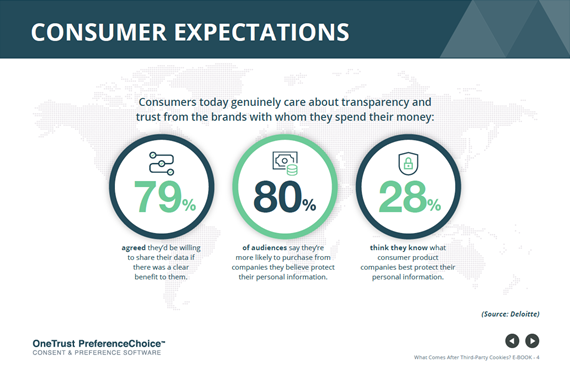Sponsored
Third-party cookies are about to crumble and it’s going to change the game for the marketing industry. So, what comes after third-party cookies? OneTrust sheds some light on everything marketers, publishers and advertisers need to know.
Cookies: The Changing Landscape
With customers demanding more privacy protection, global regulators and big tech providers are weighing in with their concerns about advertiser’s abilities to track and sell large quantities of customer data online. These rising concerns are forcing the landscape of cookies to change.
There are four main drivers pushing changes for third-party cookie tracking:
- consumer expectations
- laws and regulations
- browser changes
- ad blocking

Given the amount of data that cookies can contain, they can be considered personal data in certain circumstances and, therefore, subject to the GDPR. Other global law and privacy regulators such as the ePrivacy Directive, and the CCPA also target the use and regulation of third-party cookies.
Regulators aren’t the only force cracking down on the use of third-party cookies, major tech companies are also playing their part, straight from the source. Google have stated that by 2022 all Chrome browsers will block third-party cookie tracking. Currently, only 30% of available impressions are rendered on browsers (mostly Safari and Firefox) with no third-party cookies.
What Comes After Third-Party Cookies?
So third-party cookies are about to crumble, but is the industry prepared for a cookie-less future? In a survey conducted of more than 800 marketers, only 36% say they have a good understanding of the third-party cookie crackdown.
The removal of cookies changes the game for the entire industry. Without access to key data to improve marketing or ad performance, we’re left to wonder, “Where do we go from here?”
First- and zero-party data is the future. OneTrust suggests that as third-party cookies are phased out, businesses should shift their strategy to identify and capture personalisation preferences and data by leveraging a combination of first-party and zero-party data capture through progressive profiling.
OneTrust goes on to say "This allows businesses to build trust while providing the control and personalisation your consumers want. In addition to capturing first and zero-party data, publishers and advertisers in the ad tech landscape are exploring different strategies such as leveraging contextual advertising or more direct advertising deals."
For Steps to Build a New Strategy in a Post Third-Party Cookie World, you can download OneTrust’s eBook: What Comes After Third-Party Cookies.
The goals surrounding these steps are to provide consent and preference management to users by:
- Allowing your organisation to be completely transparent.
- Honouring your brand promise and respecting your users’ data across all the organisational systems and tech stacks.
- Not only meeting but going beyond global regulations in regard to managing user privacy data.
Third-party is out, first and zero-party data is in. Organisations need to be prepared to shift their strategy to building trust with customers through a better understanding of what they want, while also respecting and protecting their privacy. And that’s just the way the cookie crumbles.
To learn more about what comes after third-party cookies, and the steps your organisation can take, download the free eBook.
